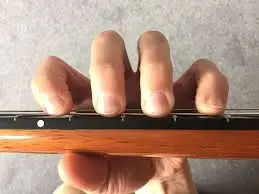Playing guitar should feel natural and effortless, but many guitarists struggle with tension and discomfort simply because of improper left-hand positioning. Whether you’re just starting out or looking to refine your technique, mastering the fundamentals of fretting hand position will dramatically improve your playing and help prevent potential injuries.

The Foundation: Proper Knuckle Alignment
The most critical aspect of proper guitar technique is knuckle alignment. Your knuckles must run parallel to the neck, not tilted at an angle. This fundamental principle is often overlooked, yet it’s absolutely essential for developing proper technique. Here’s why it matters:

- It allows equal reach for all fingers, especially the crucial third finger and pinky
- Enables larger stretches without strain
- Provides maximum efficiency for complex passages
- Reduces the likelihood of repetitive strain injuries
- Creates a solid foundation for all other aspects of technique
When your knuckles are properly aligned, your entire hand works as a unified system, allowing for fluid movement and maximum reach. Think of your hand as a precision tool – when all parts are properly aligned, it works with remarkable efficiency.
Supporting Role: Your Thumb
With proper knuckle alignment established, your thumb serves as a supportive partner in creating a solid fretting hand position:

- Position your thumb gently on the back of the neck, roughly opposite your index and middle fingers
- Keep it relaxed – many players grip too tightly, creating unnecessary tension
- Angle it slightly rather than pointing straight up or down
- Save wrapping your thumb over the top for specific techniques like Hendrix-style chord embellishments or bending strings
The Art of Finger Curvature
Your fingers should form elegant arches over the fretboard, much like a pianist’s hand position:
- Keep fingers curved naturally as if holding a softball or grapefruit
- Use fingertips to press the strings, not the pads
- Maintain flexible knuckles – tension is the enemy of speed and accuracy
- Allow each finger to move independently while maintaining the overall curved shape


Strategic Fret Placement
Where you press the string within each fret space can significantly affect both sound quality and the effort required:
- Press just behind the fret wire (not directly on it) for optimal tone
- This placement requires minimal pressure to produce clear notes
- Experiment to find the sweet spot where the least pressure produces the best sound
- Remember: more pressure doesn’t equal better tone
The Critical Role of Wrist Position
Your wrist position affects everything from your reach to your endurance:
- Maintain a neutral position that feels natural and relaxed
- For scale work, a slightly lower wrist helps fingers arch naturally over the fretboard
- When playing barre chords, subtle adjustments are fine, but avoid extreme angles
- If you feel wrist strain, reassess your position immediately
One of the most effective ways to achieve optimal wrist alignment is to adopt the classical guitar position. By holding your guitar at a 45-degree angle with the neck elevated, your wrist naturally falls into an ergonomic position that maximizes both reach and comfort. This position allows your fingers to approach the fretboard at their most mechanically advantageous angle, reducing strain and increasing efficiency.
The Path to Efficiency
Building efficient technique is about working smarter, not harder:
- Use only the pressure needed for clear notes – excess force wastes energy
- Practice slowly and mindfully, focusing on smooth, controlled movements
- Regularly ask yourself questions that help you assess the tension in your hand
- Practice in front of a mirror so you can see your hand position
Remember, developing proper technique is something you control. Be patient with yourself as you build these habits, especially if you are working on fixing poor habits. The rewards – increased speed, better tone, and pain-free playing – are well worth the effort. Keep practicing, stay mindful of your form, and most importantly, enjoy the process of becoming a better guitarist.
About The Author
Brian Fish is a professional guitarist who has been dedicated to helping other guitar players in Northeast Ohio pursue their musical dreams since 1994. He’s passionate about guiding others on their musical journey! He is the Guitar Playing Transformation Specialist, instructor, mentor, trainer, and coach at Guitar Lessons Geauga.
Brian has also assisted people from around the globe in developing a solid sense of timing and enhancing their creativity through the fantastic rhythm course, “Ultimate Rhythm Mastery,” available at MusicTheoryForGuitar.com.
If you live in Geauga County / North East Ohio, Guitar Lessons Geauga can help you become the player you’ve always wanted to be.

